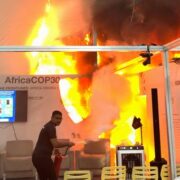Bad classrooms, broken dreams

The three powerful earthquakes that hit the Visayas and Mindanao in a span of 10 days have added another layer to the country’s severe classroom shortage and, in a bigger context, the Filipino children’s learning crisis.
The magnitude 6.9 earthquake that hit northern Cebu on Sept. 30 has totally damaged 1,187 schools, while 5,587 classrooms sustained minor damage and 803 others suffered major destruction. Last Friday’s magnitude 7.4 and 6.8 quakes that happened hours apart also damaged structures, including school buildings. Based on preliminary damage assessments, 1,164 classrooms sustained minor damage, 255 were moderately damaged, and 376 were completely destroyed.
These were only from the earthquakes. Last month’s Typhoon “Opong” totally damaged 312 classrooms while 1,101 others recorded minor damage, affecting about 13 million learners nationwide.
The Philippines already has a backlog of more than 165,000 classrooms nationwide, and these recent disasters only exacerbate the problem. It also demonstrates the substandard quality of school buildings that, if unchecked, could put at risk the lives of thousands of learners and school personnel.
Save the Children Philippines reported that 2.7 million children, or 10 percent of the country’s student population, were still unable to return to school a week after the Cebu earthquake.
Post-disaster trauma
Many of the children were scared to go back to their classrooms because of the aftershocks, fearing that they might end up being trapped if their school building collapsed in the event of another strong temblor. This disruption in the students’ daily lives could only worsen the learning crisis because they lose valuable learning time and must also deal with post-disaster trauma.
Last month, Education Secretary Sonny Angara revealed that more than 1,000 classrooms that the Department of Public Works and Highways (DPWH) turned over to the Department of Education (DepEd) were not completed.
It is of small consolation that, per Angara, these were not exactly “ghost” projects—only unfinished ones. But they might as well have been nonexistent projects because these incomplete classrooms were not painted and did not have electricity, making them useless.
This revelation shows that corruption in public works has not been limited to flood control and farm-to-market road projects, but has also extended even to institutions for learning—places where students are also supposed to learn values such as honesty and integrity that shape them to be better citizens.
Disaster-proof classrooms
This classroom crisis also brings to mind the staggering P612.5 million in confidential funds that Vice President Sara Duterte has yet to account for when she was education secretary—money that could have funded the purchase of textbooks and other education materials, salaries of teachers, even hygiene or modular kits that students can use during emergencies, and building sturdier, disaster-proof classrooms.
The DepEd estimated that only 4,000 new classrooms can be built each year, given the slow pace of the DPWH when it comes to the construction of school buildings. The government needs P413 billion to address this shortage, or from P10 billion to P14.8 billion annually, with each DPWH-implemented classroom costing between P2.5 million and P3.7 million.
To put things in perspective, the P118.5 billion allegedly lost to anomalous flood control projects from 2023 to 2025 could have already funded a third of the classroom shortage. Even Duterte’s intelligence funds could already have built 165 classrooms.
The classroom shortage problem has forced many schools to implement double or triple shifts, with some classes being held in makeshift or open-air rooms—not exactly conducive learning environments.
55 years
According to Angara, it would take 55 years to completely resolve the backlog, which has been caused by several factors, including rapid population growth, aging infrastructure, decades-long underinvestment in basic education facilities, on top of the destruction caused by calamities.
If there is one good thing that came out of the DPWH corruption scandal, it is the realignment of funds, with the education sector gaining P26 billion to build more classrooms.
The DepEd, however, must ensure that these funds will not go into the pockets of corrupt government officials and contractors. Angara must also report on the results of an audit that he had ordered on the heels of the incomplete classrooms issue. He should not stop at determining how many classrooms were lost to corruption, but also who should be held accountable and charge them in the court of law.
Corruption is a crime that deprives Filipinos many of their rights, including the right to quality education. Every time a school building is not built or a substandard classroom is destroyed, there is a student out there who loses an opportunity for a better life with an education that could have been their ticket to overcome social inequalities.

















